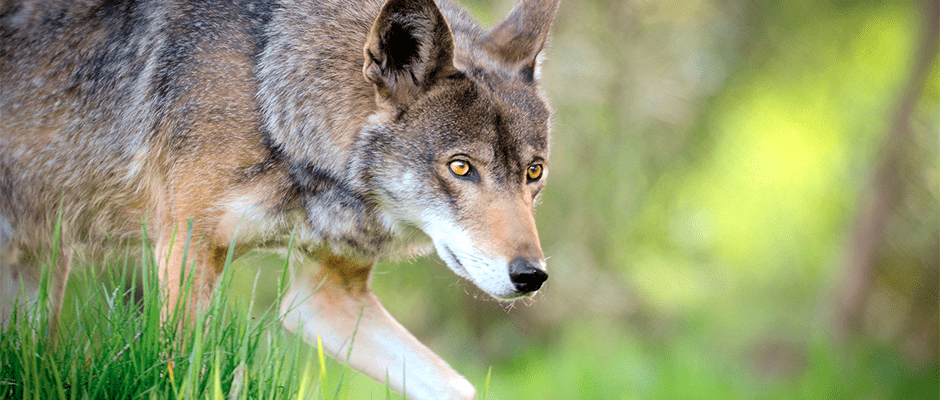Share this article
Hybrids — and maybe a full red wolf — found in former range
Red wolves (Canis rufus) were thought to be extinct in the wild, outside of a reintroduced population in North Carolina. But a pair of recent studies have found coyote (Canis latrans) hybrids carrying a high percentage of red wolf DNA in areas where the wolf hasn’t been seen for decades. Researchers believe at least one animal may be 100 percent red wolf.
The discoveries in western Louisiana and East Texas’ Galveston Island come as the U.S. Fish and Wildlife wrestles with the future of its red wolf recovery efforts. Fewer than 40 red wolves exist in an experimental population on North Carolina’s Albemarle Peninsula. Another 200 are in captivity. They’re descended from what were believed to be the last free-ranging red wolves, gathered from Louisiana and Texas in the 1970s in an effort to preserve the species.
But maybe some of the red wolves got left behind.
“I think it should be clear that not all the red wolves were captured,” said Sean Murphy, who was a large carnivore research biologist for the Louisiana Department of Wildlife and Fisheries when he conducted the research in that state.
The lead author on the study published in Conservation Letters, Murphy, a TWS member, was mostly focused on recovering the Louisiana black bear (Ursus americanus luteolus), but camera trap photos and hunters’ tales suggested that some of what were believed to be coyotes in southwest Louisiana may be hybrids with red wolves. Coyotes and red wolves are known to breed together. Some scientists believe the red wolf, which once roamed much of the Southeast, is in fact a coyote hybrid and not a separate species.

Canids believed to be coyotes show evidence of red wolf genes on Galveston Island in Texas.
©Ron Wooten Photography
Murphy’s team studied scat samples and found 55 percent had at least 10 percent red wolf ancestry. Several had more than 40 percent ancestry. One had as much as 100 percent red wolf ancestry, according to one analysis method.
“There’s a common conception that if you don’t manage the red wolf very closely in the wild it will just totally hybridize out of genomic existence,” said TWS member Kristin Brzeski, assistant professor in Michigan Technological University’s School of Forest Resources and Environmental Science and a co-lead author on the study of the Galveston canids published in the journal Genes.
“I think what’s really important and maybe surprising to some people,” Brzeski said, “is that there’s something behaviorally or physically that is allowing red wolf genetics to persist in the environment with zero management. I think that’s really important for moving forward with red wolf conservation. With minimal management we can probably help red wolf genes persist in the wild effectively.”
Co-lead author Elizabeth Heppenheimer, an ecology and evolutionary biology graduate student at Princeton University, said their team was studying canid genetics broadly and kept hearing about supposed coyotes on Galveston Island that resembled red wolves. The researchers were skeptical at first, she said, despite some convincing photos.
“We were genuinely surprised,” she said. “I was doing the initial analysis with a few other animals that had been flagged as potentially weird and I was like, ‘just a coyote, just a coyote.’ And then, ‘Oh my god, we got something here!’”
Studying tissue samples from two roadkill samples — and genetics taken from one dirty scalpel — they found red wolf “ghost alleles” present. Although the researchers did not measure the ancestry percentages, they described a “surprising amount of allele sharing with the captive breeding population of red wolves,” far more than with coyotes or other canids.
The findings suggest that these hybrids could offer additional genetic variation for red wolf reintroduction efforts, researchers said. But federal policies for protecting hybrid populations under the Endangered Species Act aren’t well spelled out. The authors of both papers urged more protections for hybrids that could play a critical role in maintaining an imperiled species’ genetics.
“There is a need to consider adopting a hybrid policy for endangered and threatened species,” Murphy said.
He believes the findings also support arguments that the red wolf is a distinct species, due to the persistence of its genes after generations of coexistence with coyotes and interbreeding.
Header Image: Captive red wolves, like this one at Point Defiance Zoo and Aquarium, descend from wolves captured in Louisiana and Texas. In the 1970s. ©Seth Bynum/PDZA








